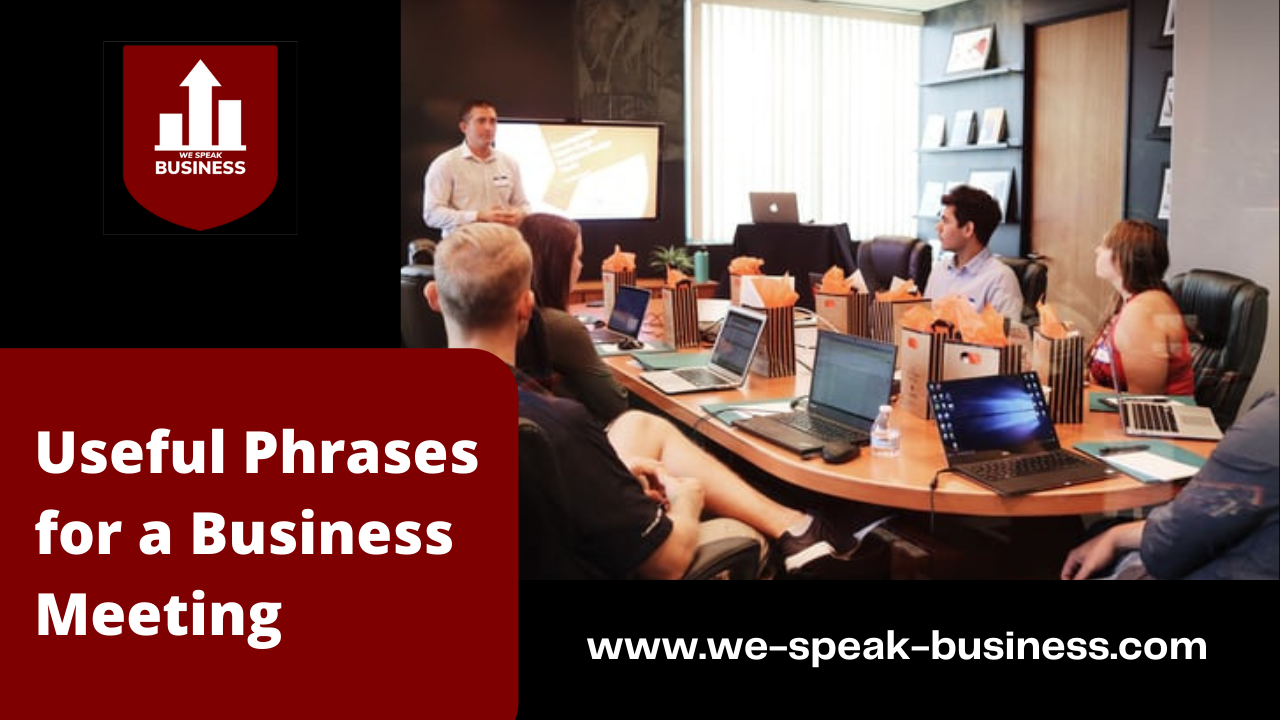Useful Phrases for a Business Meeting - Business Phrases
Aug 21, 2021
Meetings are something that every business professional faces. Whether it be online or offline, one of the biggest points for business English learners is communicating and expressing themselves clearly in different types of meetings.
This blog is going to teach you some of the most common and important phrases that you may hear and use in business meetings and conference calls.
Feel free to play around with some of the examples I share and write any questions you have below in the comments section.
Before We Start…
I’d like to invite you to an exclusive free seminar that I’m holding right now where I’m going to show you how to speak better business in just one month. In this free seminar, we’re going to look at how to set effective SMART language-learning goals, how to get motivated to learn, how to build and start enhancing your business vocabulary, and we’re also going to be looking at accent and pronunciation when speaking English at work.
To sign up for the free seminar, read the rest of this article and click the button at the bottom of the page to get started.
Now let’s jump into our main content for today. We’re going to start with phrases we can use to start a meeting in English.
Let’s go!
Starting the Meeting
When we start a meeting we should first introduce ourselves. A short, clear, and professional introduction is best.
“Hello everyone, my name is Robert Miller and I’m the president and founder of Frizbo.”
You can also substitute ‘Hello’ with a ‘Good morning/afternoon’.
“Good morning/afternoon everyone. I’m Robert Miller, president and founder of Frizbo.”
For more informal meetings where you know the attendees, you can start off by saying the following:
“Alright everyone let’s get started, you all know who I am so let’s jump in with the agenda for today.”
“Ok people let’s not waste any time and dive right in with what we’re going to be talking about today.”
Introducing the Agenda
There are several ways we can introduce the agenda in a meeting. The agenda is the main objectives; the talking points that will be discussed throughout the meeting.
When we want to introduce the agenda, we can say:

“Welcome, everyone. The purpose of today’s meeting is to discuss…”
“Thank you all for coming at such short notice. Let’s start with item number one…”
“Now that everyone’s here, let’s get started…”
When stating the agenda, make sure you keep it brief and concise. You don’t want to bore the entire room before you’ve even started, so keep it short and snappy by keeping each agenda item to 1 sentence (2 maximum).
What is We Speak Business Program
We Speak Business is an English course with live speaking lessons for English learners who want speaking practice with native speakers, professional teachers, and students from around the world.
You have live speaking lessons where you can join and start speaking business English every day. There's a lesson every day and also, you can review all record lessons. There is a lot of conversation practice for each level of English (A2, B1-B2, C1). There is a calendar of scheduled lessons so you can see when lessons are and at what time you can join and start speaking.
In We Speak Business program, you have 24/7 support and also you have student chat where you can speak with other students from all around the world. Before you join our program and start speaking business English, we strongly recommend you sign up for our free seminar with Andrew Smith, where you can learn:
- What goals you need to have to get better results
- How to master business English quickly
- What are the strategies that will help you advance to a higher level
- How you can speak business English more fluently and confidently
- Free resources to help you learn business English
- Exclusive resource to improve your speech
Bringing Up Topics for Discussion
There are certain phrases we can use in English when we want to bring up topics for discussion.
When we want to initiate a discussion on a specific topic, we can use the following phrases:
”The first item on the agenda that we need to discuss today is…”
”Let’s look at the first item on the agenda...”
“First, let’s talk about…”
“Let’s discuss the most important topic for today, which is…”
Moving On
After we’ve spoken about the first topic on the agenda, we’ll need to signal to the audience that we want to end this section and move onto the next point. We call this type of language ‘signposting language’.
Signposting languages are words and phrases we use to tell the participants and audience what will come next. They’re used in many different areas of business, but particularly in meetings and presentations.
Let’s take a look at some phrases we can use to tell the room that we’re moving onto our next key point:
“Let’s move on to [item], which is the next item on the agenda.”
“Moving on, let’s take a look at item [number] on the agenda…”
“Now that we’ve looked at X, let’s move on to Y.”
“Now we’ve come to the final item on the agenda…”
Asking for Clarification
Sometimes, we may have to clarify what someone has said if we didn’t fully understand them. Clarifying is a great tool when we are communicating with others in English and want to make sure that we’ve gotten the correct information.
There are many different ways to clarify. Take a look at some examples below as inspiration:

“Could you please clarify…?”
”I’m not sure I understand what you mean by…”
”I’m sorry, I don’t quite follow…”
”So what you’re saying is…”
”When you say X, do you mean Y?”
”Could you (just) repeat that last part for me please?”
“Could you elaborate on that for me?”
Notice how when we clarify, we’ll often use the modal verb ‘could’. We use ‘could’ and other modal verbs a lot in business English when we want to make polite requests or suggestions.
Stalling the Discussion
There will be times in meetings where you might want to stall the discussion, To stall means to stop something from continuing for a limited period of time.
You may want to stall the discussion when you want to look at a point in more detail or when an important issue has been missed or forgotten.
To stall the discussion you can use the following phrases:
“Before we move on, I think we need to look at…”
”I’m sorry, but I don’t believe we’ve talked about…”
”One minute please, it seems we haven’t discussed…”
“Wait a second, I think we need to talk about X a little more…”
Be careful when stalling a discussion to not labour a point (talk about something too much or too often), and make sure you also don’t digress (start talking about something irrelevant).
Interrupting Someone
Sometimes we will want to interrupt someone to say something we think is important to the discussion. It’s perfectly acceptable to interrupt someone in business providing you do it both politely and professionally.
Use these phrases to interrupt someone in a polite and professional manner:
“Could I (just) come in here quickly?”
“I have something to say here if you don’t mind.”
“I’d like to add to that if that’s okay with you?”
“If you don’t mind I’d like to say something here.”
You can also interrupt without using words. Simply raising your hand or/and clearing your throat are good ways to signal to others that you want to say or add something to the conversation. 
Summarising the Discussion
When we get to the end of the meeting we’ll want to summarise the meeting. To summarise means to briefly and concisely discuss what it was you’ve spoken about. When we summarise, we want to keep it short and to the point. You may also want to emphasize and stress key issues that were discussed.
Use the phrases below to summarise the discussion at the end of the meeting:
”In summary, we’re going to…”
”This is what we’ve agreed on:”
”So we’ve decided to…”
”To summarise, let’s look at what we’ve discussed today”
”To wrap up let’s go through our main points from today’s meeting”
Closing the Meeting
Finally, after we’ve summarised the key items, we’ll want to close the meeting to tell the participants that the end of the meeting has arrived. We can use this time to also answer any questions the attendees may have and to home in on important action steps for the following week(s).
To close a meeting, you can use the following phrases:
“The meeting is adjourned. Thank you all for attending.”
“I guess that will be all for today. Thanks for coming.”
“I think that’s all for today, any questions?”
“That’s everything for today. If anyone has any questions please send me an email and let me know.”
Let’s Wrap Up
I hope you’ve found the language I’ve shared with you today both useful and interesting. Try practicing some of the key phrases we’ve learned today in your next meeting or conference call.
If you want to take your business vocabulary to the next level, our free seminar will help you not only learn and remember more new business words, but we also share a unique and proven system that you can start using immediately to build and enhance your business vocabulary.
In our seminar we also talk a lot about pronunciation and accent, where we teach and show you how you should sound when speaking in English with your global clients and colleagues.
To sign up for the free seminar, click the button below to reserve your spot now!
To your success!
If you are looking to improve your speaking skills at work, then we have an exclusive free seminar where I teach you how to speak better business in 30 days. Sign up by clicking the button below!



